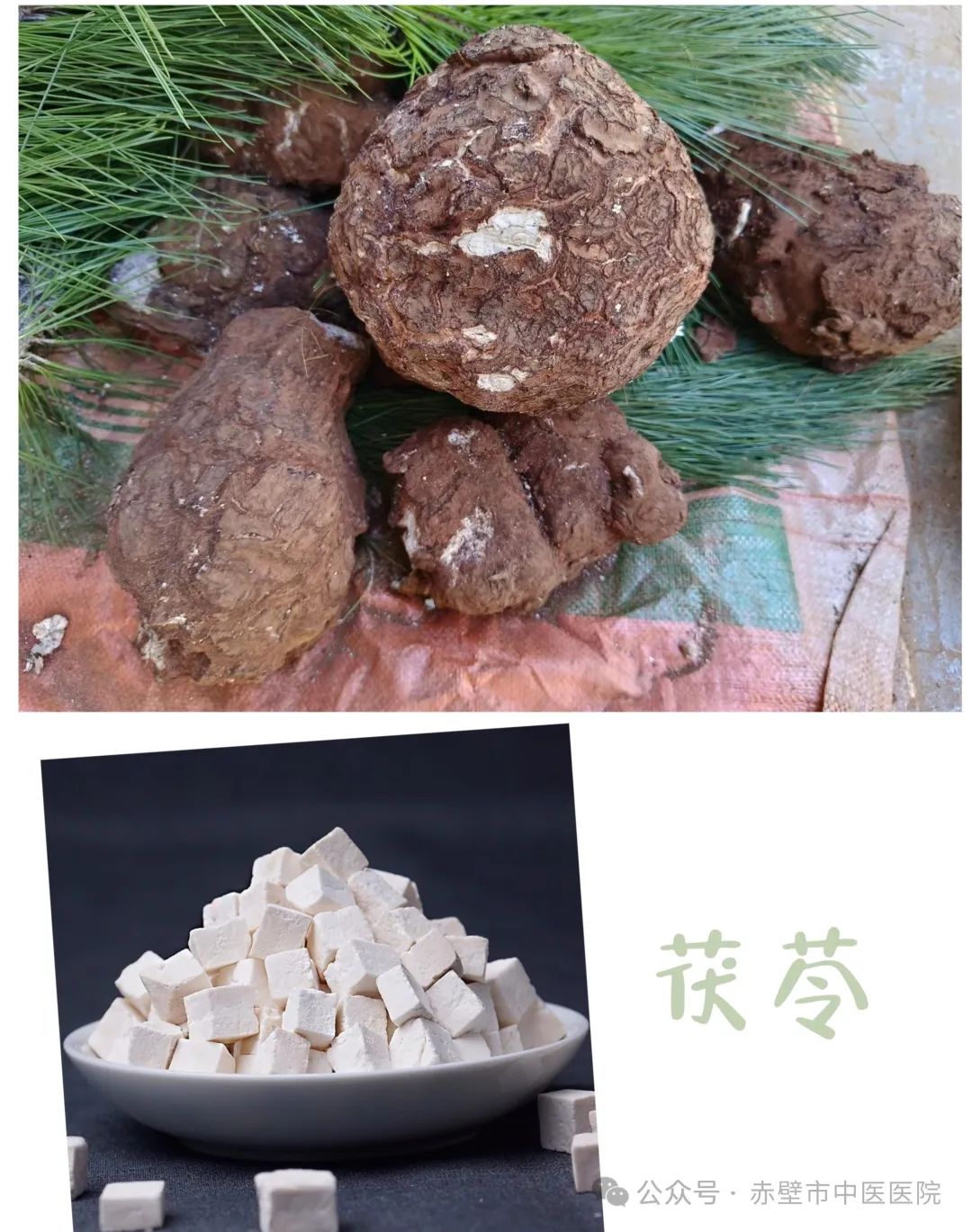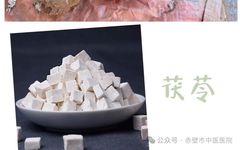
In the previous issue, we discussed Tufuling (Earth Poria), to avoid confusion, this issue will focus on Fuling (Poria).
伏苓 (Fuling)
【Morphological Characteristics】 It is the dried sclerotium of the fungus Poria cocos. It appears irregular in shape, either spherical or in clumps. The outer skin is thin and rough, ranging from brownish-yellow to dark brown, with distinct wrinkled textures. The cross-section is white, with some light red, and some contain pine roots. It has a faint odor, a bland taste, and is sticky when chewed. It is generally harvested from July to March of the following year in pine forests. The quality is best when harvested after the beginning of autumn. High-quality specimens are firm, with a brownish-yellow outer skin without cracks, a fine white cross-section, and strong stickiness.

【Aliases】 Depending on the part used, it is called Fuling Ge (Poria pieces), Fuling Pi (Poria skin), Fuling Kuai (Poria blocks), Chi Fuling (red part), Bai Fuling (white part), and Fushen (the white part with pine roots). Different parts have different effects, with Bai Fuling commonly used in clinical practice.【Processing】 After being unearthed, it is washed to remove dirt, placed in a non-ventilated corner of the room, or stored in a clay jar, layering Fuling with rice straw or pine needles, and covered with thick burlap to allow it to “sweat” and release moisture. Then, it is taken out to wipe off water droplets, spread in a cool place, and allowed to dry on the surface before sweating again. This process is repeated 3-4 times until the surface shrinks, and then it is air-dried, resulting in Fuling Ge (Poria pieces). After sweating, it is cut while still moist, or dried Fuling is soaked in water before cutting. The white part inside the Fuling sclerotium is sliced into thin pieces or small cubes, which is Bai Fuling; the red part is Chi Fuling; the black outer skin is Fuling Pi; and the white part with pine roots is cut into thin slices, which is Fushen. All processed products must be air-dried and stored in a cool place, avoiding sun exposure to prevent loss of stickiness or cracking.【Properties and Channels】 Sweet, bland, neutral. Enters the Heart, Lung, Spleen, and Kidney meridians.【Effects and Applications】 Promotes urination and leaches out dampness, strengthens the Spleen and harmonizes the Stomach, calms the mind and settles the spirit. Used for edema, reduced urination, phlegm-damp dizziness, Spleen deficiency with poor appetite, loose stools, vomiting, diarrhea, anxiety, nocturnal emissions, turbid urination, palpitations, insomnia, forgetfulness, etc. Tao Hongjing said: “White Fuling is for tonifying, while red Fuling is for draining.”【Dosage and Administration】 For internal use: 9-15g decocted in soup, or made into pills or powders. 【Cautions】 Should not be used by those with Yin deficiency without damp-heat, or those with deficiency-cold, slippery essence, or Qi deficiency with sinking.
【Cultural Significance】 According to the Records of the Grand Historian, it is referred to as “伏灵” (Fuling). Ancient people revered pine trees for their year-round greenery. Fuling is a fungus that parasitizes the roots of pine trees, growing on pine oil and cellulose. Because pine trees with Fuling often show signs of decay, ancient people believed that Fuling gathered the essence of the pine tree, forming a spirit at the roots, hence the name “伏灵” (Fuling). The name “伏灵” later evolved into “茯苓” (Fuling).
It is said that during Genghis Khan’s campaigns in Central China, continuous light rain for several months caused his soldiers to suffer from rheumatism. Just as they were about to face defeat, several soldiers accidentally consumed Fuling and recovered. He quickly transported a large quantity of Fuling from Luotian County, and after consuming it, the soldiers’ health improved, leading to victory in battle. The miraculous effect of Fuling in treating rheumatism became widely known. Generations of physicians have regarded Fuling as a superior herb, with a balanced nature, tonifying without being harsh, and draining without being forceful. Long-term use can calm the soul, nourish the spirit, moisturize the skin, and prolong life. Fuling is also considered a fine product of medicine and food, made into cakes and pastries for convenient consumption. It is suitable for those with chronic illness, weak constitution, poor appetite, frequent diarrhea, prolonged depression, and weakness in the limbs.
△ Field survey of wild medicinal herbs by the Traditional Chinese Medicine Hospital of Chibi City
Warm Reminder: All medicines have toxicity! Do not use without guidance from a TCM physician!
Traditional Chinese Medicine Field
Previous issues: TCM reminds you: There are rules for decocting Chinese medicine【Understanding Chinese Herbs】Fritillaria【Understanding Chinese Herbs】Mugwort【Understanding Chinese Herbs】Pinellia【Understanding Chinese Herbs】Hundred Parts【Understanding Chinese Herbs】Acorus【Understanding Chinese Herbs】Chonglou【Understanding Chinese Herbs】Polygonatum【Understanding Common Chinese Herbs】Tufuling
Image provided by: Qiu Yiyu
Editor: Hu Yuanxiang
Reviewer: Deng Yi’an
Long press to follow the latest updates
Scan to follow Please follow
Please follow

